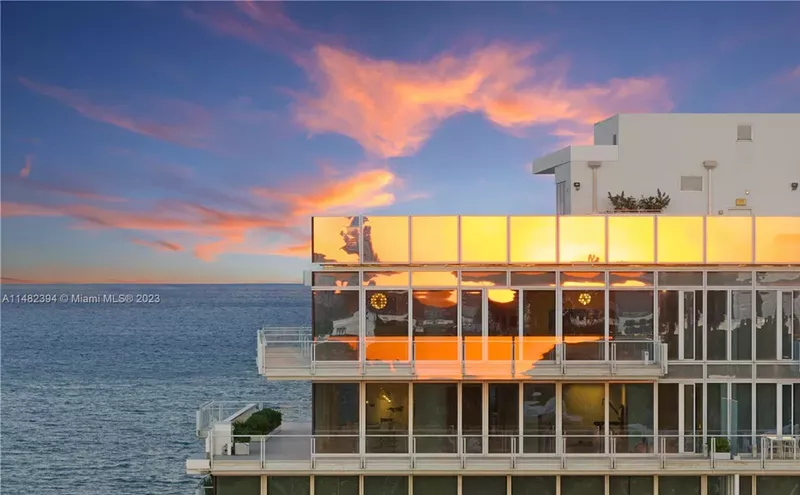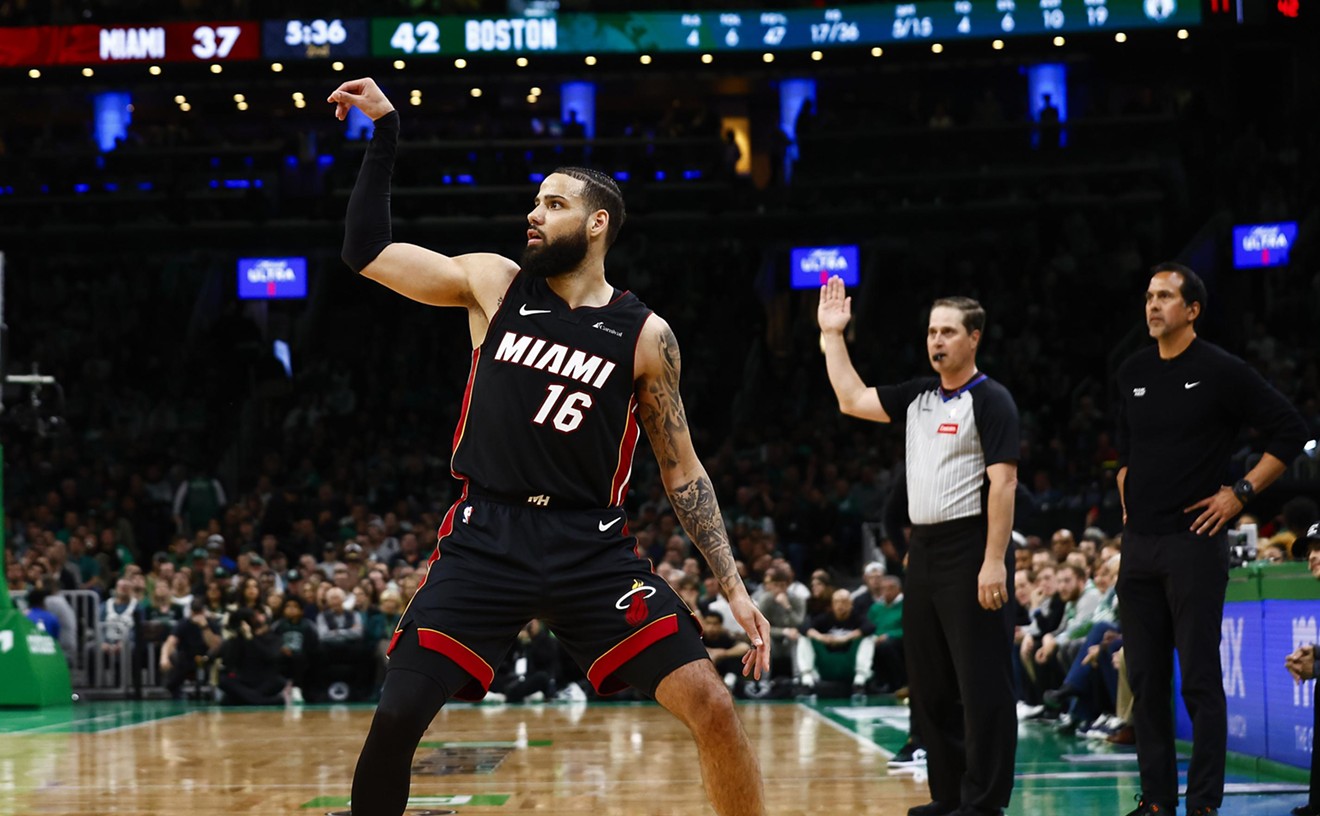The videos should be useful to Miami's thirteen-member Civilian Investigative Panel in the coming months, as panel members look into allegations of police misconduct during the FTAA demonstrations. The footage could help the CIP determine not only who instigated the disturbances in and around the downtown, but also whether the proper police response was to blast rubber bullets and beanbags into the heads of protesters and others.
In addressing the CIP last week, Timoney repeated what by now has become his stock line: Protesters, not cops, started the violence by throwing stuff. "Police officers were assaulted with all sorts of objects from golf balls to bricks to a whole host of other weapons," he told the CIP members. "Marbles and wrenches and nuts, lugs." Demonstrators and others interviewed by New Times and other news media said riot police assaulted dozens of passive protesters.
If Timoney was aware of all the video that demonstrators and independent filmmakers shot that day, he acted as if he wasn't. "There may be some complaints of bruises and what have you," Timoney conceded. "There were no head wounds as a result of police sticks across people's heads."
Unfortunately for Timoney, the gash Ryan Conrad received on the top of his head contradicts the chief's account. Conrad is a twenty-year-old who attends Bates College in Lewiston, Maine and works as a carpenter for a theater company. He was among several hundred FTAA protesters who marched to the fence surrounding downtown's Inter-Continental Hotel on the morning of November 20 amid the phalanxes of riot police. He was videotaping his fellow demonstrators on SE First Street near the corner of SE Third Avenue when police started clubbing protesters, including him.
"I was bleeding through the scarf I had on my head," Conrad told New Times during a recent telephone interview. "There was blood all over my head and all over my hands, and a medic came and grabbed me and the medic sat me down and bandaged my head." He ended up at the wellness center street medics had set up in a rented storefront at 532 N. Miami Ave., although the blows had left him so woozy that he couldn't recall exactly how he had gotten there. Medics also treated three other people who were near him at the protest and had head wounds from police sticks, Conrad said.
"Ridiculous" is how filmmaker Scott Beibin, a 32-year-old Philadelphia resident and director of the independent Lost Film Festival, described Timoney's assertion that no one was injured from a nightstick to the head. "I don't know what he considers a head," Beibin scoffed. As he was filming the morning demonstration, he said, he saw at least a dozen people whose heads were bloodied from police batons.
During Timoney's CIP appearance, the chief suggested that protesters were fortunate that riot police had opted for pepper spray pellets and Taser electric shock devices instead of batons. He has voluntarily experienced both, he noted, and found these crowd-control devices preferable to a skull-clubbing. "I'll opt for the pepper spray or the Taser anytime," he said.
No members of the panel questioned Timoney about rubber bullet or beanbag shots to the head, probably because they had yet to see any of the video anti-FTAA activists have uploaded to the Internet. Timoney testily took a few questions from CIP members, then insisted he had to rush to a prior engagement to provide security at the Boys & Girls Clubs' annual Christmas tree sale on South Dixie Highway and SW 32nd Avenue.
But salvos were fired that night which opened a new phase of the postmortem into police actions against protesters. Shortly after Timoney left the meeting, CIP members approved a motion to hold a public hearing "as soon as possible" to hear complaints and review police policy regarding the FTAA affair. Later on Timoney was clobbered by two television reporters, Michael Putney and Kellie Butler of WPLG-TV (Channel 10), who had covered the chief's CIP appearance. The tease for the station's 11:00 p.m. newscast contained footage of local filmmaker Carl Kesser's blood splattering on the lens of his video camera; while taping the police advance on protesters on the afternoon of November 20, Kesser was struck in the head with a beanbag fired by a cop. The lead story, reported by Butler, showed the filmmaker pointing at the bandages wrapped around his head and saying there was a hole "the size of a golf ball" under them. Putney was shown asking the police chief to look at the disturbing footage. Timoney refused, accusing Putney of trying to create "a Jerry Springer moment." (Timoney did not respond to a request for comment.)
Besides the videos, the CIP will also be able to consider firsthand accounts from street medics. Jeremy Savage, a 24-year-old Washington, D.C. resident and member of the DC Action Medical Network, e-mailed this account to New Times: "I treated two people in the street on November 20 with head wounds. The first was a male who was hit on his left temple with a rubber bullet and it split his head open. The split was about a half-inch long and a quarter-inch wide.... Shortly after he left we came across another male who was shot in his left eyebrow. A few centimeters lower and he would have lost the eye, I think. His main complaint was that he couldn't see out of any eye and had a massive headache. The blunt trauma blinded him. I don't know if it was permanent or not."
Beibin, the film festival director, said he saw one male demonstrator in his early twenties who had taken a rubber bullet to the eye. "It was just -- red," Beibin recalled. "I could see the cornea and the entire eye was just red, bulging." (He believes the man must now be blind in that eye, but at press time New Times hadn't been able to locate the protester.)
Timoney and Miami Mayor Manny Diaz may have thought the trouble was over, but the hitherto secretive CIP is now under the gun to deal with this situation in a very public way. The body was created by a public referendum in 2001. The Miami City Commission approved the thirteen members this past March; they first convened in June. Since then the panel has been bogged down in administrative issues and has yet to launch its first case. Unlike Miami-Dade County's Independent Review Panel, which investigates complaints against county cops, the CIP has the power to subpoena witnesses. Because police operations for the FTAA involved city and county forces, the IRP has proposed cooperating with the CIP on the hearings. The IRP has scheduled a public meeting for December 19 at its office at 140 W. Flagler St. to discuss how to respond to complaints stemming from the FTAA protests. The CIP's next meeting is scheduled for December 16; at press time the site was undetermined.
Also at press time, the Miami office of the American Civil Liberties Union had received more than a hundred complaints about police conduct during the protests, at least nine of them involving serious injuries. The CIP had taken in just five, but a request for details went unanswered. The IRP had received three formal complaints from demonstrators alleging Miami-Dade police used unnecessary force on them. IRP executive director Eduardo Diaz read a transcript of one he received by phone this past Friday from a Florida State University student: "The complainant reported that several members of the Students United for Peace and Justice were fired upon without any advance warning by Miami-Dade police. The complainant reported that he has videotaped footage of several incidents which can be viewed at www.tacitconsent.com."
Timoney may have more to worry about than CIP public hearings or a congressional investigation, being sought by trade unions that participated in the demonstrations. Since 2002 the U.S. Department of Justice's Civil Rights Division has been investigating the MPD's policies, practices, and procedures, in response to controversial killings by police and allegations of excessive use of force. This past March, Justice Department lawyer Steven Rosenbaum sent the Miami city attorney a letter outlining concerns the inquiry had turned up so far. "MPD fails to provide clear guidance on what constitutes a reasonable use of force," Rosenbaum wrote. Specifically investigators found flaws in the department's policies aimed at avoiding unnecessary use of Tasers and canines. The investigation has not delved into MPD's procedures and practices regarding rubber bullets and beanbags, nor whether it was necessary or reasonable to fire them at protesters' heads. The Justice Department may want to add that to the list.
The Civilian Investigative Panel seeks complaints from people who feel they were abused by police during the FTAA protests. A form is available at www.ci.miami.fl.us/cip or at the CIP office at 155 S Miami Ave from 8:00 a.m. to 5:00 p.m. weekdays. Complaints also can be faxed to 305-579-2436 or 305-400-5028.
Video Footage
Here is a partial list of Websites containing video from the FTAA demonstrations:










